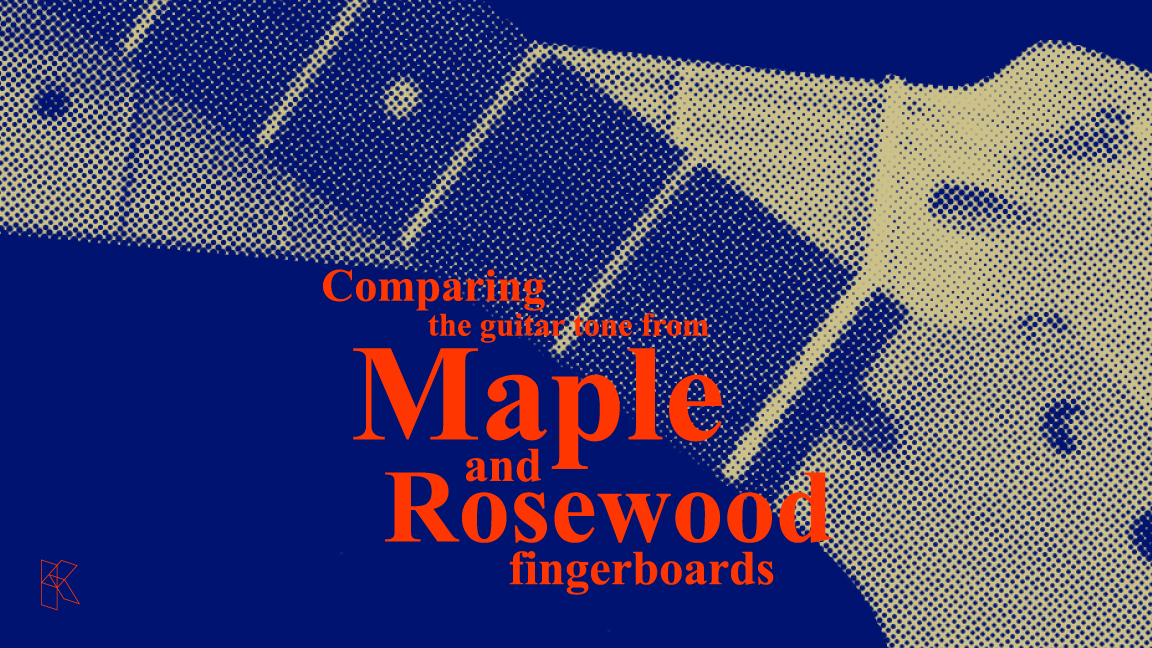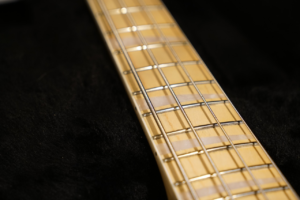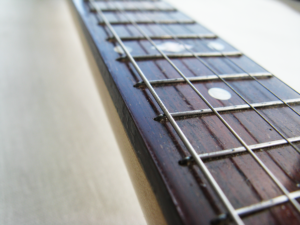
Maple and Rosewood Fingerboards
Maple and Rosewood are the most used woods in the guitar fretboards. From years of experience the guitar players prefer one or the other not only for the visuals, but also the feeling and sound produced by the fretboard material, combined with the neck wood and how the strings are perceived when playing. The properly chosen tonewood is the key to open the doors of good tone and performance!
When trying to hear the “tone” It’s easy to do the test with freshly installed strings and playing the instrument unplugged. This will give the initial impression of the “sound”. Probably the first thing you will hear is the attack difference and the perceived loudness of the strummed notes.
The maple will surprise you with brighter bell-like notes, with its “sharp” highs and better note to note separation when playing chords. Since it is light colored hardwood it is often protected with hard polyurethane lacquer and that hardens the surface further. On the other side the beauty of the rosewood will shine with the darker and more deep tone, the notes are blooming with a little slow attack, when the instrument is plugged into an amplifier. The feeling when playing vibrato will be different too. Keep in mind, playing the instrument through an amp or an amp simulator will reveal more of the wood properties. But the first raw impression is the important one. Later when dialing your clean, rhythm and lead tones, the wood and the combination of the guitar hardware, especially the pickups, will give you the full impression. Guitars are a complex musical instrument and the right combination of the wood and the hardware, especially the material of the bridge, also the nut and the electronics is what makes the instrument shine with a unique timbre. All of this is a good “guide” when it comes to buying a new guitar or when it’s hard to decide which fingerboard wood material is good for us.
 The maple fingerboard is a light colored wood and it is often covered with varnish lacquer for protection and this leads to quite different overall performance.
The maple fingerboard is a light colored wood and it is often covered with varnish lacquer for protection and this leads to quite different overall performance.
Tip: Worth mentioning that rosewood needs regular conditioning with oils, to protect the wood from drying and preserve it from the hand oils and the dryness or too much moisture from the air. Use “Lemon Oil” like https://www.jimdunlop.com/formula-65-fretboard-ultimate-lemon-oil/ when changing your strings to clean the board. But don’t flood it! Oil the board and see if it soaks into the pores for a few seconds, then wipe it out with a soft piece of fabric!
Maple:
https://en.wikipedia.org/wiki/Maple
- Sharp with fast attack. Hard.
- Tight low end.
- Slick feeling under the fingers because of the finish.
- Neck is built from one piece or separate fingerboard
- Bright.
It’s not only visually appealing with its whitish shade and grain patterns, but the maple is used for hundreds of years in the luthiery craft. From the Stradivari violins to today’s best boutique guitars, the maple is used for guitar necks and fingerboards. It’s strong, durable and long term resistant to wraps. When tapped with a finger, the fretboard or neck blank rings with short – fast and high pitched notes. So, it’s a timbre wood with qualities proven by the time. Some guitar players find that lacquered maple board feels like a smooth layer of glass over the fretboard, easy to move over the neck and lessen the tension, especially when bending tones.
 Rosewood is dark and porous wood . It is usually unprotected.
Rosewood is dark and porous wood . It is usually unprotected.
Rosewood:
https://en.wikipedia.org/wiki/Rosewood
- Loose low-end.
- Blooming notes.
- High end is warm and mellow.
- Used in many guitars. Separated construction from the neck.
- Rich and full
In reality the rosewood is much harder wood from the maple, but due to its porous structure and natural oils percentage, it is quite different. Because of the difference of the growth condition, each board has a unique shading of the grain. There are a few different tree species and each one is providing different qualities.The middle and high notes are full of sonic information and they are well balanced. When playing with distorted tones, the notes are enriched with overtones. The sustain is a little bit longer. Some guitarists find the unfinished rosewood to be easier to play with a velvet sense of touch, while others find it to be quite resistant when bending. It’s all about a personal choice and feel.
Maple or rosewood. Which one is for you?
It’s all subjective. Or not? It could be scientifically proven with many tests that the wood really matters. The guitar is an object that depends on vibrations, each material has its own properties and each wood transfers the vibration with different speed. Of course we are talking about electric guitars and there are more elements coming into consideration. Each piece of the construction adds up to the final picture. When choosing a guitar, test it unplugged first. Listen for the overall resonance. Listen for “dead” notes. Then plug it in your amp or amp simulator software. Dial up a clean amp and strum a few chords. Don’t go crazy with the gain, approach it as an “acoustic” instrument. The woods are unpredictable materials. That’s why the luthiers are always coming to the proven ones. Maple or Rosewood, they are just different colors in your musical palette. It’s even better to own instruments with both materials for different tone qualities. And don’t forget to enjoy them!

